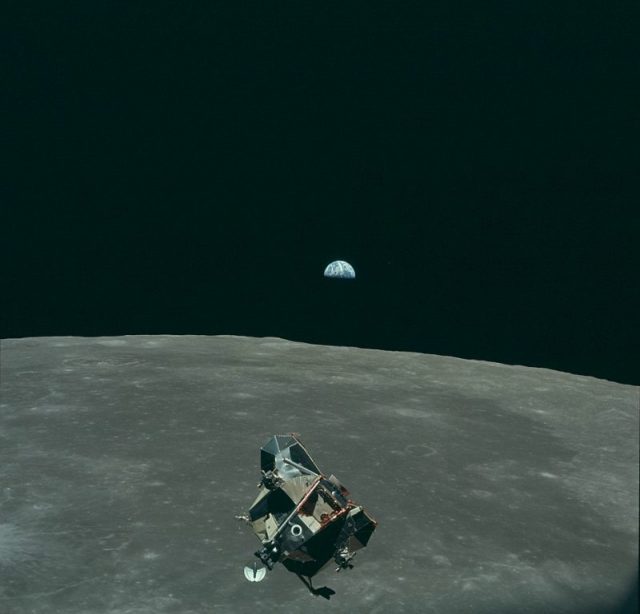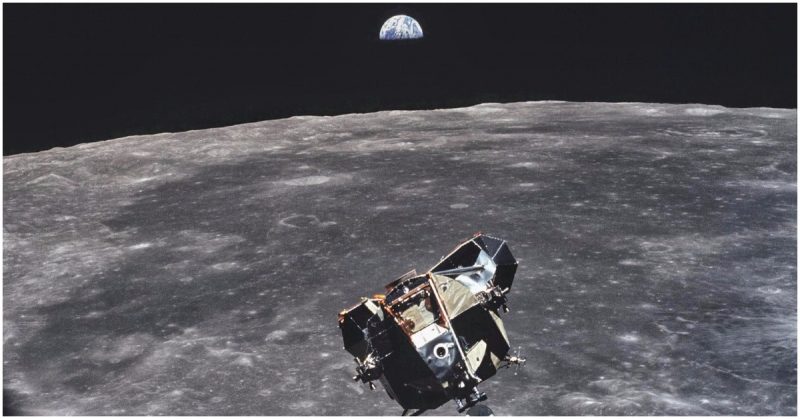Some photographs are more iconic than others, and that may be particularly true about this one, released by NASA. It shows the lunar module Eagle returning from the moon’s surface on July 21, 1969, and about to rendezvous with Columbia, the command module of the Apollo 11 mission. In the background, we can see Earth too.
Neil Armstrong, as well as Buzz Aldrin, are both inside the lunar module at the moment the camera clicked. Back on the command module is Michael Collins, all alone. He is the astronaut who didn’t get his footprints on the Moon and is probably the least “famous” of all three Apollo 11 crew members.
Hold your thoughts for a moment, because there is one unusual aspect about this photograph that we can take into consideration. At the moment when this photograph was taken, its photographer, Michael Collins, was the only earthling, the single representative of the human species, dead or alive, who does not appear in it. At least that’s what the Law of Conservation of Mass from classical physics allows us to think.
The team of Rare Historical Photos reports on this aspect of the photograph. The law claims that matter can’t be created nor destroyed in an isolated physical system, which in this case would be the Earth itself. However, matter can still change from one form to another. And since humans are formed by matter, we can maintain it in one form or another.
Hence, if you were alive and kicking at the moment this photograph was captioned, then your matter was on Earth. Even if you weren’t planned in 1969, the matter that eventually became you was already there on Earth. Which means you are also in the picture. It also means your dearly departed are on it too–they have just changed their form.

Everyone involved in the historic Apollo 11 mission in 1969 stayed cool about the dangers involved, but there certainly were some uneasy feelings, especially among crew members, whose lives were at the mercy of what could happen in space.
As part of the moon-landing mission, first proposed by President John F. Kennedy to the U.S. Congress in 1961, Lieutenant Colonel Michael Collins had other mission tasks. Unlike his colleagues, Commander Neil Armstrong and Colonel Edwin Eugene “Buzz” Aldrin, who both got to do the moonwalks, Collins was the pilot of the command module and had to wait for the other two to return from the Moon’s surface.
When the lunar module Eagle detached itself from its mothership on July 20, 1969, four days after the team departed from the Kennedy Space Center and entered the lunar orbit, Collins was suddenly a lone wolf in space. “Keep talking to me, guys,” an anxious Collins reportedly to his colleagues as they drifted away from the ship in which Collins needed to sit almost an entire day, all alone.
Moments later, he was Earth’s most distant solitary voyager, over 230,000 miles of space away from his kind and repeatedly hidden by the Moon, which means radio signals stopped reaching his mission control cabin. “It is there, reinforced by the fact that radio contact with the Earth abruptly cuts off at the instant I disappear behind the moon,” he would note in his cabin.
Cut from any contact with his home planet, Collins recounts his thoughts during this experience: “I am alone now, truly alone, and absolutely isolated from any known life. I am it. If a count were taken, the score would be three billion plus two on the other side of the moon, and one plus God knows what on this side.”
Not only did he need to deal with solo-orbiting the Moon for almost a day, but Collins also had concerns that the Eagle, which needed to return his crew-mates to him, might not fire up. Everyone was aware that the chances for any casualties were fair. In case things didn’t work out well with the Eagle, it would have meant that Collins was the mission’s single survivor. Even President Nixon was ready to address the nation in the circumstances of such a disaster.
Collins did not hide his fears, a story in the Guardian says. At the time, he wrote: “My secret terror for the last six months has been leaving them on the Moon and returning to Earth alone.” The recollection continues: “If they fail to rise from the surface or crash back into it, I am not going to commit suicide; I am coming home, forthwith, but I will be a marked man for life, and I know it.”
All was well at the end. After Armstrong and Aldrin logged some 20 hours and 30 minutes on the surface of Moon, making the historic walk, raising the American flag and chatting with the President of the United States, among other things, they returned all safe and sound to the command module, and the team of three set a course to home.
The fears of Collins remained only fears. Unlike Armstrong or Aldrin, after the mission, the name of Collins was not mentioned frequently. Not that Collins seems to have minded. On the occasion of the 40th mission anniversary, Apollo 11’s least-known astronaut commented that “it was an honor” to be part of such mission.
The truth is he has never felt detached from the mission in any way. According to one of his earlier statements: “This venture has been structured for three men, and I consider my third to be as necessary as either of the other two.”
Now aged 87, Collins remained in NASA until 1970, by which time he had logged 266 hours in space. After NASA, he was appointed as a director at the National Air & Space Museum in Washington, D.C., for eight years.
Concerning the photograph above, it remains to be one of the most moving, perhaps most touching, of all photos ever taken from space.
